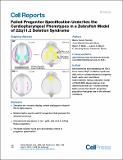| dc.contributor.author | Guner-Ataman, Burcu | |
| dc.contributor.author | González-Rosa, Juan Manuel | |
| dc.contributor.author | Shah, Harsh N. | |
| dc.contributor.author | Jeffrey, Spencer | |
| dc.contributor.author | Abrial, Maryline | |
| dc.contributor.author | Burns, C. Geoffrey | |
| dc.contributor.author | Burns, Caroline E. | |
| dc.contributor.author | Butty, Vincent L G | |
| dc.contributor.author | Boyer, Laurie Ann | |
| dc.date.accessioned | 2018-09-07T17:43:56Z | |
| dc.date.available | 2018-09-07T17:43:56Z | |
| dc.date.issued | 2018-07 | |
| dc.date.submitted | 2018-05 | |
| dc.identifier.issn | 2211-1247 | |
| dc.identifier.uri | http://hdl.handle.net/1721.1/117677 | |
| dc.description.abstract | Microdeletions involving TBX1 result in variable congenital malformations known collectively as 22q11.2 deletion syndrome (22q11.2DS). Tbx1-deficient mice and zebrafish recapitulate several disease phenotypes, including pharyngeal arch artery (PAA), head muscle (HM), and cardiac outflow tract (OFT) deficiencies. In zebrafish, these structures arise from nkx2.5⁺ progenitors in pharyngeal arches 2–6. Because pharyngeal arch morphogenesis is compromised in Tbx1-deficient animals, the malformations were considered secondary. Here, we report that the PAA, HM, and OFT phenotypes in tbx1 mutant zebrafish are primary and arise prior to pharyngeal arch morphogenesis from failed specification of the nkx2.5⁺ pharyngeal lineage. Through in situ analysis and lineage tracing, we reveal that nkx2.5 and tbx1 are co-expressed in this progenitor population. Furthermore, we present evidence suggesting that gdf3-ALK4 signaling is a downstream mediator of nkx2.5⁺ pharyngeal lineage specification. Collectively, these studies support a cellular mechanism potentially underlying the cardiovascular and craniofacial defects observed in the 22q11.2DS population. Microdeletions encompassing the TBX1 locus cause 22q11.2 deletion syndrome (DS), which is characterized by congenital heart, aorta, and craniofacial malformations. Using a zebrafish model of 22q11.2DS, Guner-Ataman et al. demonstrate that tbx1-mutant animals fail to specify the nkx2.5⁺ progenitor population that gives rise to the affected structures. Keywords: Tbx1; cardiopharyngeal; zebrafish; nkx2.5; heart; DiGeorge; 22q11; progenitor; arch artery | en_US |
| dc.publisher | Elsevier | en_US |
| dc.relation.isversionof | http://dx.doi.org/10.1016/j.celrep.2018.06.117 | en_US |
| dc.rights | Creative Commons Attribution-NonCommercial-NoDerivs License | en_US |
| dc.rights.uri | http://creativecommons.org/licenses/by-nc-nd/4.0/ | en_US |
| dc.source | Elsevier | en_US |
| dc.title | Failed Progenitor Specification Underlies the Cardiopharyngeal Phenotypes in a Zebrafish Model of 22q11.2 Deletion Syndrome | en_US |
| dc.type | Article | en_US |
| dc.identifier.citation | Guner-Ataman, Burcu et al. “Failed Progenitor Specification Underlies the Cardiopharyngeal Phenotypes in a Zebrafish Model of 22q11.2 Deletion Syndrome.” Cell Reports 24, 5 (July 2018): 1342–1354 © 2018 The Author(s) | en_US |
| dc.contributor.department | Massachusetts Institute of Technology. Department of Biology | en_US |
| dc.contributor.mitauthor | Butty, Vincent L G | |
| dc.contributor.mitauthor | Boyer, Laurie Ann | |
| dc.relation.journal | Cell Reports | en_US |
| dc.eprint.version | Final published version | en_US |
| dc.type.uri | http://purl.org/eprint/type/JournalArticle | en_US |
| eprint.status | http://purl.org/eprint/status/PeerReviewed | en_US |
| dc.date.updated | 2018-08-30T13:01:32Z | |
| dspace.orderedauthors | Guner-Ataman, Burcu; González-Rosa, Juan Manuel; Shah, Harsh N.; Butty, Vincent L.; Jeffrey, Spencer; Abrial, Maryline; Boyer, Laurie A.; Burns, C. Geoffrey; Burns, Caroline E. | en_US |
| dspace.embargo.terms | N | en_US |
| dc.identifier.orcid | https://orcid.org/0000-0003-3491-4962 | |
| mit.license | PUBLISHER_CC | en_US |
